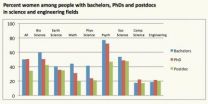(Press-News.org) It's March 2013 – 50 years after Betty Friedan's explosive book launched feminism's "second wave," 41 after Title IX, the equal-opportunity amendment banning sex discrimination in education, was signed into law – and some exceptionally successful women are making a lot of news. Former U.S. Secretary of State Hillary Clinton is riding high in public opinion, winning straw polls for the 2016 presidency. Yahoo CEO Marissa Mayer, after shrugging off maternity leave, has sparked the "Great Telecommuting Debate" with a company-wide ban on working from home. And Sheryl Sandberg, Facebook's chief operating officer, is on the cover of TIME and every other national stage, it seems, talking about "Lean In," her just-published memoir and "sort of feminist" manifesto on succeeding as a female in corporate America.
The very presence of these women would seem to contradict the need for a national dialogue on women in the workplace that Sandberg is urging. Except that it doesn't. These women are rare exceptions – according to a report from the Center for Research on Gender in the Professions at the University of California, San Diego.
The report details ongoing inequalities in the American labor market on the basis of gender.
"In our society we tend to look at the individual for explanations of success – education, hard work, moral fiber and so on. Even Sheryl Sandberg's critique is focused on the personalities and willpower of individual women. But there are also structural factors at work, not just individual," said lead author Mary Blair-Loy, associate professor of sociology in Division of Social Sciences at UC San Diego and founding director of the Center for Research on Gender in the Professions. "Our report looks at the broad patterns shaping life chances that individuals may not be aware of – the underlying trends that continue to shape women's and men's opportunities in the workforce."
The report, "The Persistence of Male Power and Prestige in the Professions," contradicts the "end of men" story popularized by Slate's Hanna Rosin, the New York Times' David Brooks and others. Oversimplified, the male-decline narrative holds that the 2008 recession hit "men's jobs" (in the construction, manufacturing and high-finance sectors) hardest and that women, who were already outpacing their Y-chromosome peers in going to college and earning associates and bachelor's degrees, are overtaking men in the new, service economy.
What that story ignores, said Blair-Loy, is that not all service-economy jobs are created equal.
Women are well-represented, at times even over-represented, in the low-paying service jobs (think retail or hospitality), but men continue to dominate in the highest paid and most highly regarded careers.
The report surveys the status of women and men in the American workforce and provides three in-depth case studies in the professions of law, medicine, and science and engineering. The team focused on these three for two reasons: They are some of the best-paid occupations in the service economy. And they are historically male-dominated fields where women have made tremendous gains in education.
"Women are under‐represented in all three professions," Blair-Loy and her report coauthors write. "They are rarest in the most powerful sectors and at the highest levels." In Marissa Mayer's industry of science and engineering, women make up only 21 percent of scientists and engineers. In science/engineering university teaching, women hold 36 percent of adjunct and
temporary faculty positions, but only 28 percent of tenure‐track and 16 percent of full professor positions. In the medical profession, women are only 34 percent of physicians but 91 percent of registered nurses. In law firms, where Hillary Clinton started out, women make up 45 percent of associates but only 15 percent of equity partners.
The gender pay gap continues as well. "The momentum of movement toward income equality gained in the 1970s and 1980s has largely stagnated since the mid-1990s," the report authors write. Reviewing the latest available data, they state that among full-time workers, women earn only 81 percent of what men do. In the prestigious professions that the report scrutinizes, the gap is just about the same: In science and engineering, the figure is 86 percent on average. Among lawyers, it is 87 percent, and among physicians and surgeons, 79 percent. Even after controlling for work time, experience, specialty, and other factors, significant wage gaps between women and men professionals persist, Blair-Loy said.
Blair-Loy and her coauthors document not only that women are paid less and are under-represented past the entry level but also that the numbers of women earning advanced degrees that qualify them for these professions in the first place have stagnated and even slightly declined since the mid-2000s.
Why? "Four decades after Title IX, the low-hanging fruit is gone, and the why is complicated," Blair-Loy said. "There are a series of interlocking factors that include workplace cultures that privilege men and cognitive biases that shape what we notice and remember about male and female workers. Even the most well-intentioned people among us default to cultural stereotypes – that men are more likely to be competent and professional while women are more likely to be warm and nurturing – that undermine our efforts to reward talent alone."
The ongoing inequity is neither fair nor smart, said Blair-Loy. It's not good for individuals, for organizations or for society as a whole.
"The first step is to see through this myth that women are doing better than men," she said. "The second is to thank Sheryl Sandberg for inciting discussion about gender disparities in the workplace. But to solve this issue, we need to look beyond the behavior of individuals and to recognize the structural barriers that continue to disadvantage and discourage.
"We need to make legal and organizational changes," said Blair-Loy, author of the award-winning book "Competing Devotions: Career and Family among Women Executives." Changes will need to range "from better access to childcare and greater acceptance of flexible work schedules to more transparent hiring, evaluation and promotion procedures."
INFORMATION:
'End of men'? Not even close
2013-03-20
ELSE PRESS RELEASES FROM THIS DATE:
Mechanical forces play key role in assembly and disassembly of an essential cell protein
2013-03-20
Researchers have for the first time demonstrated that mechanical forces can control the depolymerization of actin, a critical protein that provides the major force-bearing structure in the cytoskeletons of cells. The research suggests that forces applied both externally and internally may play a much larger role than previously believed in regulating a range of processes inside cells.
Using atomic force microscopy (AFM) force-clamp experiments, the research found that tensile force regulates the kinetics of actin dissociation by prolonging the lifetimes of bonds at low ...
SMU Lyle School of Engineering course sparks CCL study
2013-03-20
DALLAS (SMU) – The Innovation Gym in SMU's Lyle School of Engineering was buzzing and clanking on a recent morning as students tested robots they built for a specific task – collecting and remediating water samples, as Lyle faculty and students have been doing by hand in refugee camps in Africa and Bangladesh.
The strong work dynamic that emerged among members of the first-year design class and their embrace of the inter-disciplinary team approach used to teach it has drawn the attention of the Center For Creative Leadership, which will send a team of researchers to ...
Altered brain activity responsible for cognitive symptoms of schizophrenia
2013-03-20
Cognitive problems with memory and behavior experienced by individuals with schizophrenia are linked with changes in brain activity; however, it is difficult to test whether these changes are the underlying cause or consequence of these symptoms. By altering the brain activity in mice to mimic the decrease in activity seen in patients with schizophrenia, researchers reporting in the Cell Press journal Neuron on March 20 reveal that these changes in regional brain activity cause similar cognitive problems in otherwise normal mice. This direct demonstration of the link between ...
Some Alaskan trout use flexible guts for the ultimate binge diet
2013-03-20
Imagine having a daylong Thanksgiving feast every day for a month, then, only pauper's rations the rest of the year.
University of Washington researchers have discovered Dolly Varden, a kind of trout, eating just that way in Alaska's Chignik Lake watershed.
Organs such as the stomach and intestines in the Dolly Varden doubled to quadrupled in size when eggs from spawning sockeye salmon became available each August, the researchers found. They were like vacuums sucking up the eggs and nipping at the flesh of spawned-out salmon carcasses.
Then, once the pulse of eggs ...
Spiral beauty graced by fading supernova
2013-03-20
Supernovae are amongst the most violent events in nature. They mark the dazzling deaths of stars and can outshine the combined light of the billions of stars in their host galaxies.
In 1999 the Lick Observatory in California reported the discovery of a new supernova in the spiral galaxy NGC 1637. It was spotted using a telescope that had been specially built to search for these rare, but important cosmic objects [1]. Follow-up observations were requested so that the discovery could be confirmed and studied further. This supernova was widely observed and was given the ...
Estrogen helps keep joint pain at bay after hysterectomy
2013-03-20
CLEVELAND, Ohio (March 20, 2013)—Estrogen therapy can help keep joint pain at bay after menopause for women who have had a hysterectomy. Joint pain was modestly, but significantly, lower in women who took estrogen alone than in women who took placebo in the Women's Health Initiative (WHI) trial. The findings were published online today in Menopause, the journal of The North American Menopause Society.
Studies looking at how estrogen affects joint pain in women after menopause have had mixed results. But this analysis of data on some 1,000 women who had hysterectomies—representative ...
Estrogen may relieve post-menopausal joint pain
2013-03-20
Post-menopausal women, who often suffer from joint pain, could find some long-term relief by taking estrogen-only medication, according to a new study based on the Women's Health Initiative (WHI) that was released online today by the journal, Menopause.
Previous studies of estrogen's influence on joint symptoms had produced mixed results, so researchers examined the findings of the WHI, the largest-ever study of the use of hormonal therapy in post-menopausal women. They examined the findings of the women enrolled in the Estrogen-Alone program, in which women who had undergone ...
Discovery of first motor with revolution motion in a virus-killing bacteria advances nanotechnology
2013-03-20
Scientists have cracked a 35-year-old mystery about the workings of the natural motors that are serving as models for development of a futuristic genre of synthetic nanomotors that pump therapeutic DNA, RNA or drugs into individual diseased cells. Their report revealing the innermost mechanisms of these nanomotors in a bacteria-killing virus — and a new way to move DNA through cells — is being published online today in the journal ACS Nano.
Peixuan Guo and colleagues explain that two motors have been found in nature: A linear motor and a rotating motor. Now they report ...
A milestone for new carbon-dioxide capture/clean coal technology
2013-03-20
An innovative new process that releases the energy in coal without burning — while capturing carbon dioxide, the major greenhouse gas — has passed a milestone on the route to possible commercial use, scientists are reporting. Their study in the ACS journal Energy & Fuels describes results of a successful 200-hour test on a sub-pilot scale version of the technology using two inexpensive but highly polluting forms of coal.
Liang-Shih Fan and colleagues explain that carbon capture and sequestration ranks high among the approaches for reducing coal-related emissions of the ...
Explaining how extra virgin olive oil protects against Alzheimer's disease
2013-03-20
The mystery of exactly how consumption of extra virgin olive oil helps reduce the risk of Alzheimer's disease (AD) may lie in one component of olive oil that helps shuttle the abnormal AD proteins out of the brain, scientists are reporting in a new study. It appears in the journal ACS Chemical Neuroscience.
Amal Kaddoumi and colleagues note that AD affects about 30 million people worldwide, but the prevalence is lower in Mediterranean countries. Scientists once attributed it to the high concentration of healthful monounsaturated fats in olive oil — consumed in large amounts ...



